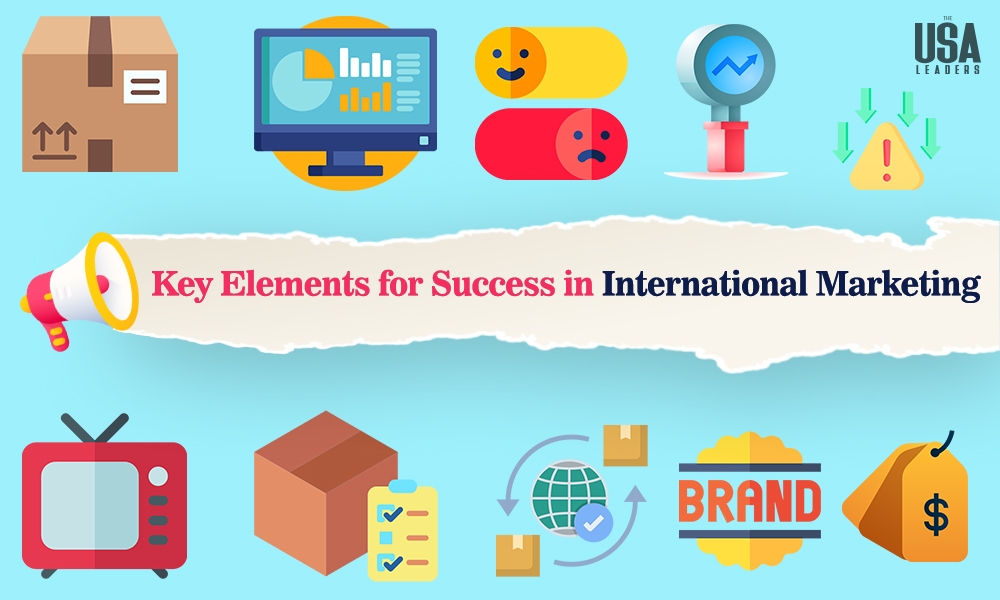International marketing, as its name implies, entails marketing on a global scale while astutely considering global operational disparities, commonalities, and opportunities to attain global objectives. It represents a crucial facet of general business administration, offering products, solutions, and services at local, national, and international levels. In 2023, the international market held a valuation of $523 billion, with a projected growth to $807.92 billion by 2028, manifesting an impressive 9.1% CAGR. This dynamic global market boasts high competitiveness, with both large and small players ardently competing for market share. Therefore, if you aspire to expand your business internationally, this blog stands as the ultimate and most comprehensive guide to comprehending international marketing.
Key Elements for Success in International Marketing

Research: Conducting thorough research represents the crucial initial step when entering the global market. During this phase, companies invest significantly in understanding their target audience and the product market. Comprehensive research allows your company to identify market trends and assess demand. For example, Amazon allocates $42.74 billion to research and development.
Product Adaptation: Effectively marketing your product or service requires customization according to the region where you plan to market it. This includes making adjustments to design, packaging, and features, and aligning them with local preferences and demands.
Pricing Strategy: To successfully market your product, your company should establish competitive and region-specific pricing strategies, considering various factors. First, consider currency exchange rates. Second, analyze local competition. Lastly, evaluate the purchasing power of the target market. For example, the iPhone 13 Pro costs $999 in the United States but €1,159 in Germany.
Distribution Channels: As a business person, it’s essential to carefully select the right distribution channels or promote your product through local retail stores in a specific country. This step is crucial for a successful market entry. Therefore, making informed decisions to effectively enter a product market is essential.
Promotion and Advertising: Effectively marketing a product requires customizing the campaign to align with the local culture and language. This involves tailoring advertising, branding, and communication strategies accordingly. Furthermore, culturally sensitive approaches are crucial in this context.
Logistics and Supply Chain: Efficient logistics management guarantees secure and punctual product delivery, preserving their quality across the entire supply chain.
Market Entry Strategy: Deciding on the mode of entering the international market is important. You can enter the market through exports, joint ventures, or subsidiaries. This choice should be based on the product market and your business objectives.
Risk Management: When venturing into a new market, it’s crucial to be aware of associated risks. These risks include currency fluctuations, political instability, cultural misunderstandings, and economic instability. Notably, Tesla boldly entered the Chinese market in 2014, despite China having some of the world’s strictest regulations on electric vehicles.
Legal and Regulatory Compliance: Ensuring compliance with international trade laws is crucial. Therefore, understanding import and export regulations, as well as intellectual property rights, is essential to prevent legal complications in your business operations.
Market Monitoring and Adaptation: To ensure the longevity of your product in a changing market, consistently monitoring market demands is essential. Consequently, you should adapt your strategies accordingly. For instance, Netflix employs data analytics to track user preferences in shows and movies. This data informs recommendations for users and enables the cancellation of unpopular shows. By actively monitoring and responding to market shifts, your product can better meet evolving consumer needs.
Brand Consistency: Maintaining consistent brand messaging and image across different markets is crucial. In fact, this is essential for building a global brand identity. Coca-Cola is a brand that has mastered this, as evidenced by its iconic logo and colors, as well as its consistently positive and uplifting messaging.
6 Global Marketing Trends to Adopt in 2023
Embrace a Brand Purpose: In today’s competitive market, discerning customers carefully select their preferred brands. To stand out in international marketing, it is essential to establish a clear and distinctive brand purpose that captures customers’ attention and entices them to purchase your products. For instance, Nike’s brand purpose is to “inspire and innovate for every athlete worldwide.” This purpose permeates everything Nike undertakes, from its product lines to its marketing campaigns. Nike’s “Just Do It” campaign exemplifies how the company leverages its brand purpose to connect with customers, motivating them to pursue their aspirations.
Prioritize User-Generated Content: User-generated content (UGC) offers a powerful avenue for effortlessly promoting your products. According to Nielsen, a study revealed that 90% of consumers trust UGC more than traditional advertising due to its authentic and trustworthy nature. For example, a photo featuring someone using your product is more persuasive to potential customers than one taken by a professional photographer.
Enhance the Customer Experience: In 2023, brands must concentrate on crafting exceptional customer experiences. Present-day customers are more likely to exhibit loyalty towards brands based on the quality of the experience they provide. Brands seeking to elevate their customer experience should explore technological solutions. For instance, Netflix provides a personalized streaming experience by leveraging data to recommend movies and TV shows tailored to each customer’s preferences. Additionally, Netflix allows users to create custom profiles, ensuring a personalized experience for each family member.
Embrace Conversational Marketing: Conversational marketing, a prominent trend, emphasizes establishing real-time, one-on-one connections with customers through friendly and personal interactions. This approach enhances the customer experience by swiftly resolving issues, ultimately boosting customer loyalty and satisfaction.
Utilize Diverse Media Channels: Unlike in the past, where companies relied on a single media channel for international marketing, businesses must now diversify their approach. Today, successful marketing entails using a variety of media channels to reach a broader audience. For instance, companies may employ social media, search engine marketing, and email marketing to promote their products. Also, businesses should enable proper analytics and use a real-time marketing funnel dashboard to understand the impact of media channels. By leveraging multiple channels, businesses can extend their reach and enhance their chances of success.
Implement a Content Marketing Strategy Centered on Providing Answers: In 2023, brands should pivot their content strategy towards delivering direct responses to user queries. This adjustment is crucial because more people are turning to search engines for information, seeking content that is pertinent and informative.
8 Techniques for Entering Worldwide Markets

To break into a new market, your company can employ various marketing strategies, including the following:
Exporting: Exporting involves the sale of goods or services produced in one country to another. There are two primary types of exporting: direct and indirect. In direct exporting, the company sells its products directly to customers in the foreign market, accomplished through channels like establishing a sales office, hiring a distributor, or selling online. In indirect exporting, the company sells its products to a third party, such as an export agent or distributor, who subsequently markets the products to foreign customers.
Piggybacking: If your company is familiar with businesses that sell products similar to yours internationally, you can consider partnering with them to incorporate your product into their product line. This mutually beneficial arrangement can boost profits for both parties.
3Countertrade: Countertrade is an international marketing method where goods are exchanged instead of money, in contrast to traditional marketing, where goods are exchanged for currency. Countertrade can help circumvent the use of currency, navigate import quotas, and gain entry into new markets. While it lacks specific legal regulations, it can be a cost-effective approach to international business.
Licensing: Licensing involves one company (the licensor) granting another company (the licensee) the right to use its products, such as trademarks, patents, or copyrights, in exchange for a fee.
Franchising: Franchising is a business model that permits one company (the franchisor) to grant another company (the franchisee) the rights to utilize its business model, products, and branding. In return, the franchisee pays the franchisor a fee and a share of the profits.
Company Ownership: If you wish to sell your product in another country without dealing with shipping and distribution, consider acquiring an established company in that location. This approach allows you to avoid the complexities of setting up your own operations while capitalizing on the existing infrastructure and relationships of the acquired company. Establishing a local presence can also enhance trust and drive sales.
Outsourcing: Outsourcing entails hiring another company to perform non-core tasks. When entering new markets, outsourcing can help you collaborate with a company experienced in that market, simplifying the process of selling your products there. This strategy enables you to bypass the expenses and risks of launching your own operations in a new market while benefiting from the partner company’s knowledge and local expertise.
Joint Ventures: Some companies establish joint ventures with others to market their products in different countries. Joint ventures reduce the risk of entering a new market by sharing costs and responsibilities. Furthermore, they often achieve greater success than individual companies would because they can combine their resources and expertise.
Benefits of International Marketing
International marketing offers numerous advantages that contribute to a higher standard of living, efficient resource utilization, cost-saving opportunities, international cooperation, cultural exchange, surplus production utilization, foreign exchange facilitation, and industrial development:
Enhanced Standard of Living: International marketing significantly enhances people’s quality of life and prosperity in different countries by granting them access to goods and services otherwise unavailable.
Resource Optimization: The global market generates demand for new products as diverse countries harbor distinct needs and desires. This demand fuels economic growth, creating jobs and fostering innovation.
Comparative Cost Benefits: International marketing aids participating nations in reducing production and distribution costs, leading to cost-effective operations.
Fostering International Cooperation: By facilitating mutual understanding, international marketing brings countries closer together, helping them resolve differences amicably.
Cultural Exchange: International marketing fosters global social and cultural exchange, promoting the cross-border flow of goods, services, and ideas. This, in turn, helps break down cultural barriers and fosters intercultural understanding.
Surplus Production Utilization: Countries with surplus goods can export them to nations in need, facilitating trade and mutual support.
Foreign Exchange Facilitation: International marketing simplifies the process of acquiring foreign currency to purchase machinery and technology.
Industrial Development Boost: International marketing enables countries to export their products, stimulating their industries and expanding infrastructure.
International marketing plays a vital role in global trade, economic growth, and infrastructure development. Moreover, it empowers businesses to expand across borders and flourish in today’s interconnected economy. Companies can successfully navigate international markets and boost the export of goods and services through the use of effective strategies and cultural sensitivity. Thus, in our interconnected world, international marketing’s significance has never been greater, making it indispensable for businesses aiming to thrive in the global marketplace.
ALSO READ: 10 Programming Languages to learn and to scale your skills






















